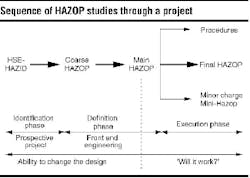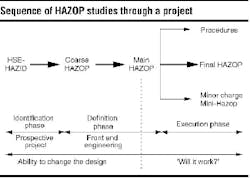DRILLING TECHNOLOGY: Drilling safety conditions evaluated in North Sea under-balanced well series
Prior to 1996, underbalanced drilling (UBD), including low or reduced hydrostatic head wells, had never been performed offshore in the North Sea. However, sound economic justification provided the stimulus to introduce this technique and associated technology.
There were many significant safety challenges that had to be addressed to demonstrate that the risks were within the limits of tolerability and as low as is reasonably practical. The primary health, safety, and environmental (HS&E) concerns related to:
- Loss of containment (continuous pressure at surface)
- Competence of personnel (UBD differs from conventional drilling operations)
- Safely designing, installing, and operating the new technology required for offshore UBD activities.
While UBD had been successfully carried out in many onshore environments, it was recognized that this experience did not readily translate to an offshore North Sea environment. At the outset of planning for underbalanced operations, the UBD Project Team decided to adopt a step-wise approach that required each progressive and discrete UBD step to be safe prior to moving onto the next stage. This required testing and acceptance of the surface facilities for reduced hydrostatic head operations, UBD, and the snubbing system for drilling, tripping, and running slotted liner under-balanced. Also, this requires killing the well during tripping.
The introduction of UBD to Shell Expro U.K.'s Gas Supply Group occurred in May 1996 with the planning of Leman A27-S2. The well was designed as a low/reduced hydrostatic head sidetrack in a depleted reservoir. Prior to operations, an extensive training program for all crew involved in the operations was completed. Although the well was effectively overbalanced, a complete UBD surface separation and nitrogen gas generation system was installed on the rig to provide the level of reduced head required and to test the surface separation system. The well was killed while tripping, so a snubbing unit was not required. At the end of this well, a UBD test was conducted (flowing reservoir fluids to surface while in the drilling mode).
Other wells
The second well was drilled in Barque through a virgin reservoir. Based on the success of the previous well, the reservoir section was drilled in the UBD mode, although the well was still killed during trips. This allowed the UBD surface facilities to be more comprehensively tested to evaluate whether the next stage could be safely managed.
The third well was drilled fully under-balanced using a snubbing unit. A slotted liner was run while maintaining an under-balance condition on the reservoir. Eight more wells have since been drilled and completed fully under-balanced.
The technique and technology is now considered to be relatively mature, although the technique and technology are constantly evolving to provide a fit-for-purpose and a more effective and efficient system. Today, wells are drilled and completed without the loss of production due to killing.
Safety issues
Key safety studies and study techniques employed during UBD are as follows:
- Loss of containment - blowout: The risk of an uncontrolled blowout is one of the major contributors (40-60%) of the overall risk picture in connection with offshore operations. The increasing focus on risk has resulted in greater attention in the validity of the risk presented in quantitative risk analysis (QRA). Current UK statutory requirements require an assessment of risk to personnel and the identification of preventative and mitigating measures to ensure that risks to personnel are as low as is reasonably practicable. Since underbalanced drilling was proposed as an alternative to conventional overbalanced drilling, a comparison of the relative risks had to be presented. If the risks from UBD were found to be higher than for conventional drilling, risk prevention study work had to be done to identify mitigating measures to ensure that risks were as low as reasonably practicable.
- Loss of containment - other than blowout: UBD requires that a hydrocarbon process system be installed on the rig. This allows separation of drilling and reservoir fluids and gases for re-use or disposal, as appropriate. Consequently, studies included the evaluation of risks from fire and explosion plus the means of escape.
- Barrier failure: To quantify the hazards associated with new tools, failure modes and effects analysis (FMEA) is used. The FMEA helps identify those failures that have unwanted effects on system operation (safety critical failures). FMEA also provides for improvements in the systems reliability and/or safety and provides an aid to fault diagnosis.
- Erosion: The UBD Project Team recognized the potential for erosion in the surface facilities given the relatively high velocities that could be achieved together with solids in gas. Consequently, significant resources were employed to construct an erosion management system that attempted to model and predict erosion potential in order to design out, or limit erosion and to identify "hot spots" to focus detection strategies.
The following techniques were used extensively during the project life-cycle:
- HAZID and HAZOP processes: The hazard identification technique (HAZID) identifies and describes occupational HS&E hazards and threats at the earliest practicable stage of a development or venture. It takes the form of a meeting employing a highly experienced multi-discipline team using a structured brainstorming technique, based on a checklist of potential HS&E issues, to assess the applicability of potential hazards. This technique is a rapid identification and description process only, not a forum for trying to solve potential problems. Typical studies applying HAZID during a UBD project might include conceptual HAZID for UBD systems and interfaces, and HAZID for layouts and logistics. The hazard and operability analysis (HAZOP) is a structured hazard identification tool, for process systems, also using a multi-disciplinary team. It assesses the hazards and operability issues associated with the surface facilities, such as the surface separation, gas injection, and rig systems (where physical interfaces occur) and snubbing unit control systems.
- Physical effects modeling: Tools such as HAZID and HAZOP are used to determine what could go wrong with an activity or process, whereas physical effects modeling assesses the consequences of a release in terms of inventory, dispersion, fire, and explosion. Given that UBD introduces additional hydrocarbon processing systems onto a location, the possible severity of a release should be evaluated for the potential for further escalation.
UBD safety management
The HS&E management system (HS&E MS) for an underbalanced drilling operation has the same components as that of any other drilling operation. However, the emphasis shifts in particular areas, such as competency, to reflect the specific risks presented by UBD.
Formally, an HS&E management system is a reflection of the objectives of an enterprise and the manner in which these objectives are to be met as laid down by its senior management. Achievement of the hazard management objectives will be realized through the setting up of an organization in which responsibility is assigned and to which resources are provided. Those with the necessary expertise define the standards and procedures through which the objectives will be met. Key elements of the SMS model for successful UBD operations are:
- Leadership and commitment: Demon-strations of commitment to the HS&E MS at different management levels include, among others, (1) allocating the necessary resources, such as time and money, to HS&E matters, (2) setting a personal example in day-to-day work, (3) putting HS&E matters high on the agenda of meetings, from the Leadership Team downwards, being actively involved in HS&E activities and reviews, at both local and remote sites, (4) communicating the importance of HS&E considerations in business decisions, (5) recognizing good HS&E performance when objectives and targets are achieved, (6) encouraging employees' suggestions for measures to improve HS&E performance, and (7) participating in internally driven and externally driven HS&E initiatives.
- Policy and objectives: The key features are (1) the contractor as well as the operator promotes active participation of all its employees in the establishment and observance of measures to safeguard their health and safety at work and to protect the environment, and (2) it expects its subcontractors to work to similar high standards and achieve comparable performance.
- Organization: One of the critical features of the UBD organization is the introduction and integration of the UBD supervisor in the offshore and onshore UBD teams. This role is a specialist position and fills the gap between theory and practice and between drillers and toolpushers to provide technical support (due to lack of experience with UBD) and continuity and coordination of operations.
- Competence: All staff has to be competent to perform the responsibilities of their jobs or be in the process of gaining such competence in a supervised manner. Those who can discharge their responsibilities safely and effectively should only perform work roles that are key to the HS&E management of the operation. UBD presents a major change from conventional drilling practice, in terms of general operations, tripping, and well control, and therefore requires significant effort to develop UBD competencies before work starts.
- Review of contractor's HS&E MS/HS&E case: The introduction of UBD equipment and its associated organization and procedures may modify an existing rig and drilling safety case.
- Documentation: A UBD project generates documentation additional to conventional drilling operations.
- Human factors (human error and ergonomics): As part of the hazard and effects management process (HEMP) were undertaken, a human factors study was carried out. The study, aimed at improving the "fit" between people, their tasks, and working environment, was carried out offshore in April 1998. This type of study was considered important, given that UBD, in this context, presented a continuous/batch process that involved various companies carrying out different tasks, all of which required coordination.
Occupational health/hygiene
In the occupational health and hygiene area, there were other factors:
- Noise and vibration: Depending on the nature of the UBD activity, various facilities may be required. For example, in the case of the Leman A27 low/reduced hydrostatic head well, there were six feed air compressors feeding two booster compressors, all of which were located on the main deck of the Santa Fe Britannia. Given the steel structure of the deck and the proximity of the compressors to the work areas, offices, and accommodation, noise and vibration was a significant potential problem. Consequently, various measures were required in the design and installation of the plant to ensure that occupational and recreational (amenity) health and safety was not compromised.
- Discharges to atmosphere: The use of diesel compressors and the nitrogen generating plant located within a relatively small working area can result in an oxygen discharge from the nitrogen generating plant that could seriously affect flammability limits, and exhaust emissions from the diesel plant. The exhausts from the diesel compressors were ducted to a discharge point that ensured no impact to personnel.
UBD should not be regarded as an extension to existing well engineering techniques and technologies. To ensure a safe operation, most UBD projects will require significantly more resources and planning in comparison with conventional well operations, if the risk of failure is to be minimized. The primary HS&E concerns relate to loss of containment, competence of personnel, and safely designing, installing, and operating the new technology required for offshore North Sea UBD activities.
All these objectives can be safely achieved but require careful attention to detail to ensure that hazards are not missed and that suitable and sufficient controls are designed and implemented to demonstrate as low as reasonably practicable.
Editor's Note: This is a summary and update of the SPE/IADC 67688 paper presented at the SPE/IADC Drilling Conference held earlier this year in Amsterdam, The Netherlands.

